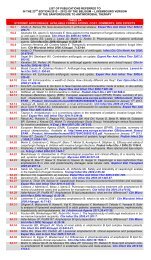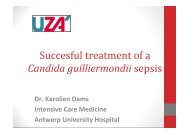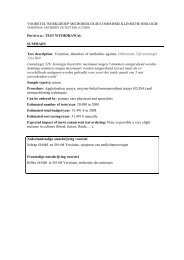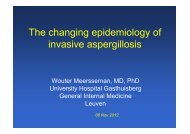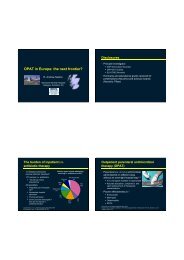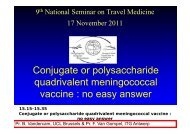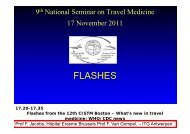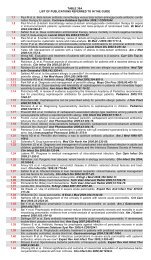CNS presentation of Lyme disease
CNS presentation of Lyme disease
CNS presentation of Lyme disease
- No tags were found...
You also want an ePaper? Increase the reach of your titles
YUMPU automatically turns print PDFs into web optimized ePapers that Google loves.
The answer• If your referenceis…the net• If your referencearescientific medicalpublications• There is no doubt• there is no doubtHe hasneuroborreliosisHe does not haveneuroborreliosis
Why he does not haveneuroborreliosis ?
What do we need to make diagnosis <strong>of</strong>neuroborreliosis ?• Symptoms• Serological confirmation‣ corner stones for diagnosis• symptoms are not specific,• serology is neither reproductible, neither relevant <strong>of</strong> evolutive<strong>disease</strong>‣ This lead to wrong diagnosis– All symptoms are considered– Serological testing are mis interpreted• … can we isolated the bacteria ?
<strong>Lyme</strong> borreliosismicrobiology• Three main species– B. burgdorferi sensu stricto– B. garinii– B. afzelii• Other species– B. valaisiana,– B. lusitaniae,– B. spielmannii.• Epidemiology– B. Burgdorferi in United States– In Europe all species are present‣ Is it really the same <strong>disease</strong> ?
<strong>Lyme</strong> <strong>disease</strong>the three steps <strong>of</strong> diagnosisTick biteSerologicaltestingSymptoms
The tick in Europe : Ixodes ricinus3 stages• larva• nymph• adult (male and female)
Microbiological Epidemiology– infestation rates <strong>of</strong> the ticks• 5 à 40 % according to the country» larvae : 4,8 %» nymph : 11,4 %» adults : 7,4 %– Seroprevalence in forestry workers• 10 to 35 %
I. Ricinus in Europe
<strong>Lyme</strong> <strong>disease</strong>the three steps <strong>of</strong> diagnosisTick biteSerologicaltestingSymptoms
Symptoms <strong>of</strong> <strong>Lyme</strong> Borreliosishistorical features• Skin manifestations known since more than100 years– Afzelius in 1909 : Erythema migrans– Buchwald in 1883 : Acrodermatitischronica atrophicans• Neurological manifestations– Garin and Bujadoux in 1922 meningoradiculitisafter tick bite– Also call : Bannwarth’s syndrome• Articular manifestations Steere in 1977 :<strong>Lyme</strong> <strong>disease</strong>• Correlation between Borrelia and <strong>Lyme</strong><strong>disease</strong> in 1982
Symptoms <strong>of</strong> <strong>Lyme</strong> borreliosiskinetic features• Primary <strong>Lyme</strong> <strong>disease</strong>– Following some days to some weeks after tick bite• Early or Secondary <strong>Lyme</strong> <strong>disease</strong>– Approximately from three weeks to 3 months after tickbite• Late manifestations– More than several month evolution• Post <strong>Lyme</strong> <strong>disease</strong>– Sequellae ?
NeuroborreliosisAt which stage ?• Early manifestations– At the very least 3 weeks after tick bites– Sometimes before seroconversion– Mainly : facial palsy• Secondary manifestations– Mainly radiculitis• Late manifestations– Encephalopathy, myelitis• Post <strong>Lyme</strong> <strong>disease</strong>– …
Early LNB• PNS manifestations.– most common manifestation in Europe : meningoradiculitis(Bannwarth’s syndrome)• radicular pain (in 86% <strong>of</strong> the patients)• paresis (in 61%) especially facial palsy, less <strong>of</strong>ten the abducensor the oculomotor nerves, sometimes the abdominal wall or thelimbs• typically exacerbates at night.• Headache (43%)• lymphocytic meningitis• other peripheral neurological manifestations (in 5–10% <strong>of</strong> thepatients) : plexus neuritis and mononeuritis multiplex.European national neurological societies guidelines.Mygland et al. Eur J Neurol, 2010 ; 17 : 8-16
Early LNB• <strong>CNS</strong> manifestations.– <strong>CNS</strong> involvement is rare,– Myelitis : poliomyelitis-like syndromes– Encephalitis : confusion, cerebellar ataxia, opsoclonus–myoclonus, ocular flutter, apraxia, hemiparesis or Parkinsonlikesymptoms,– acute stroke-like symptoms caused by cerebral vasculitis arerare and have been documented only in single case reports.European national neurological societies guidelines.Mygland et al. Eur J Neurol, 2010 ; 17 : 8-16
Late neuroborreliosis• PNS manifestations.– mononeuropathy,– radiculopathy– polyneuropathy : a causative relationship betweenpolyneuropathy and borrelial infection cannot bebased on the sole detection <strong>of</strong> Bb specificantibodies in patients with polyneuropathy as thoseantibodies can also be found in 5–25% <strong>of</strong> healthypersons.European national neurological societies guidelines.Mygland et al. Eur J Neurol, 2010 ; 17 : 8-16
Late neuroborreliosis• <strong>CNS</strong> manifestations.– cerebral vasculitis– chronic progressive <strong>Lyme</strong> encephalitis– encephalomyelitis with tetraspasticsyndrome, spastic– ataxic gait disorder anddisturbed micturition.European national neurological societies guidelines.Mygland et al. Eur J Neurol, 2010 ; 17 : 8-16
Neuroborreliosis an exemple in a recenttherapeutic surveyJ. Oksi, Eur J Clin Microbiol Inf Dis, 2007 ; 26 : 571-581• Inclusion Criteria used :– lymphocytic meningitis,– cranial neuritis,– paresis,– radiculoneuritis,– Encephalomyelitis– Peripheral neuropathy(confirmed by ENMG)– Encephalopathy (confirmed byneuropsychiatric tests)• Observed manifestations (n = 145)– Lymphocytic meningitis without radiculitis :18– Meningoradiculitis : 27– Paresis 5– Encephalomyelitis : 4– Encephalopathy : 6– Facial paresis : 21– Sudden deafness : 6– Tinnitus 8– Other cranial nerve involvement : 13– Peripheral neuritis : 6– Other peripheral nervous systemmanifestations : 24– Headache without meningitis 39– Dizziness or vertigo 29– Transient global amnesia, epileptiformconvulsions 1– Memory impairment 11
What do we need for thediagnosis ?• Primary <strong>Lyme</strong> <strong>disease</strong>Erythema migrans• Secondary and late <strong>Lyme</strong> <strong>disease</strong>• Typical signs AND serological confirmations• Neuroborreliosis– CSF analysis– Borrelia very rarely isolated into the tissue– Pleiocytosis : lymphocytic meningitis– Specific antibodies– intra thecal synthesis <strong>of</strong> specific antibodies– PCR Borrelia : very low sensitivity– Borrelia culture : very low sensitivity ; can be interestingin early neuroborreliosis
<strong>Lyme</strong> <strong>disease</strong>the three steps <strong>of</strong> diagnosisTick biteSerologicaltestingSymptoms
Diagnosis <strong>of</strong> neuroborreliosisserology testing– Ab present 4 to 6 weeks after beginning <strong>of</strong>infection (first IgM,secondarly IgG)– Can stay• several months for IgM• Several years for IgG risk <strong>of</strong> false positive tests
Serology two-step approachScreening testELISAConfirmation test :Western BlotUsed for serologic andCSF testingLack <strong>of</strong>standardisationInterpretation inCSF ???
ELISA• neuroborreliosis– sensitivity 21 à 98 % according to the type <strong>of</strong> serology– specificity 69 à 99 % according to the type <strong>of</strong> serology• A positive specific antibody response may persist formonths or even years after successful treatment <strong>of</strong>the infection• No follow-up <strong>of</strong> antibody titer
Western blot• First antibodies in early borreliosis– IgM p 41– puis IgG p41• American criteria– IgM : at leat 2 among p24, p39, p41– IgG : at least 5 among p19, p21, p28, p30, p39, p41,p45, p58, p66, p93• No european criteria• Lack <strong>of</strong> reproductibility
CSF analysis• Intrathecal synthesis <strong>of</strong> Bb antibody orspecific CSF/serum antibody index• ELISA• Good positive predictive value
Diagnosis criteria
EUCALB case definitionClinical case definitionLaboratoryevidence: essentialLaboratory/clinicalevidence: supportingIn adultsmainly meningo-radiculitismeningitis, +/- facial palsyrarely encephalitis,myelitis;very rarely cerebralvasculitis.In childrenmainly meningitis and facialpalsy.CSFPleocytosisanddemonstration <strong>of</strong>intrathecal specificantibody synthesisDetection <strong>of</strong> B.burgdorferi s.l. byculture and/or PCR fromCSF.Intrathecal synthesis <strong>of</strong>total IgM, and/or IgGand/or IgA.Specific serumantibodies. Recent orconcomitant EM
European national neurological societiesguidelines• Definite LNB.– The following three criteria are fulfilled:– neurological symptoms suggestive <strong>of</strong> LNB (with other causes excluded);– CSF pleocytosis;– Bb specific antibodies in CSF (produced intrathecally).• Possible LNB.– Two out <strong>of</strong> these three criteria are fulfilled.• If criterion III is lacking; after a duration <strong>of</strong> 6 weeks, there has to be found Bb-specific antibodies in theserum.• These criteria apply to all subclasses <strong>of</strong> LNB except for late LNB with polyneuropathy where the followingshould be fulfilled for definite diagnosis:– Peripheral neuropathy– Clinical diagnosis <strong>of</strong> ACA– Bb-Specific antibodies in serum..Mygland et al. Eur J Neurol, 2010 ; 17 : 8-16
Treatment <strong>of</strong>neuroborreliosisEvidence based review
Antibiotic choice for neuroborreliosis• High-dosage intravenous penicillin is aneffective treatment for neuroborreliosis– Steere AC, et al. Ann Intern Med 1983; 99: 767–772.• Ceftriaxone showed equivalence or a betterefficacy at 2 g/day than penicillin.– Dattwyler RJ, et al. Lancet 1988; 1: 1191–1194.– Pfister HW, et al. Arch Neurol 1989; 46: 1190–1194.
Antibiotic choice for neuroborreliosis• Ceftriaxone was effective in cases <strong>of</strong>neuroborreliosis where penicillin had failed, and canalso be used in children with neurological involvement– Dattwyler RJ, et al. Ceftriaxone as effective therapy in refractory <strong>Lyme</strong><strong>disease</strong> J Infect Dis 1987; 155: 1322–1324• Among patients with <strong>Lyme</strong> encephalopathy,characterized by loss <strong>of</strong> memory, ceftriaxone is ableto improve the clinical signs in some, but not all, cases– Logigian EL, : Successful treatment <strong>of</strong> <strong>Lyme</strong> encephalopathy withintravenous ceftriaxone. J Infect Dis 1999; 180: 377–383.
Doxyxyclin and neuroborreliosis• Several studies show equivalent efficacy (200mg/day, 3 weeks) compared to ceftriaxone and highdosageintravenous penicillin• Karlsson M, et al.: Comparison <strong>of</strong> intravenous penicillin G and oral doxycycline for treatment <strong>of</strong> <strong>Lyme</strong>neuroborreliosis. Neurology 1994; 44: 1203–1207.• Dattwyler RJ, et al:Ceftriaxone compared with doxycycline for the treatment <strong>of</strong> acute disseminated <strong>Lyme</strong>borreliosis. N Engl J Med 1997; 337: 289–294.• Dotevall L, et al. Successful oral doxycycline treatment <strong>of</strong> <strong>Lyme</strong> <strong>disease</strong>-associated facial palsy and meningitis. ClinInfect Dis 1999; 28: 569–574.• In other studies, neurological complications occurredafter doxycycline treatment,– poorly diffusion into the CSF ?– When dosage increased to 400 mg/day : equivalence to ceftriaxone• Borg R, et al.: Intravenous ceftriaxone compared with oral doxycycline for the treatment <strong>of</strong><strong>Lyme</strong> neuroborreliosis. Scand J Infect Dis 2005; 37: 449–454.• Oral doxycycline as efficient as intravenousceftriaxone– inclusion criteria including patients with Bb antibodies in serum,without any other biological criteria• Ljostad Lancet Neurology, 2008 ; 7 : 6988-690.
Guidelines
Treatment <strong>of</strong> nervous system <strong>Lyme</strong><strong>disease</strong>• Halperin et al. Neurology, 2007 ; 69 : 91-102• †These two oral regimens are effective in non-nervous system <strong>Lyme</strong> borreliosis. There are no data demonstrating efficacy inneuroborreliosis but large numbers <strong>of</strong> patients have been treated with these regimens for other forms <strong>of</strong> <strong>Lyme</strong> <strong>disease</strong> withoutobvious subsequent onset <strong>of</strong> nervous system involvement. As such they may be an oral alternative in individuals who cannot takedoxycycline.
European national neurological societiesguidelinesMygland et al. Eur J Neurol, 2010 ; 17• Adult patients with Bannwarth syndrome– single 14-day course <strong>of</strong> antibiotic treatment.– Oral doxycycline or IV ceftriaxone or IV penicillin or IVcefotaxime are effective and safe treatments (level B).– Oral doxycycline (200 mg daily) and IV ceftriaxone (2 gdaily) for 14 days are equally effective (level A).• Adult patients with early LNB with <strong>CNS</strong>manifestations– IV ceftriaxone (2 g daily) for 14 days
Some specific situations
Facial palsy• The Infectious Disease Society <strong>of</strong> America recommends the use<strong>of</strong> amoxicillin in absence <strong>of</strong> meningitis• However, there is only a descriptive noncomparative studysupporting this recommendation.• So, the use <strong>of</strong> ceftriaxone or doxycycline, by analogy with therecommendations for other forms <strong>of</strong> neuroborreliosis (includingperipheral neuropathy without meningitis), should be considereduntil more data can justify the use <strong>of</strong> oral amoxicillin.
Late stage neuroborreliosis• There is no clinically evident benefit for longdurationtreatments.• Klempner, N Engl J Med, 200; 345 :85-92• Fallon et al. Neurology, 2008 ; 70 : 992-1003• Krupp et al. Neurology, 2003 ; 60 : 1923-1930• Only a 28-day ceftriaxone (2 g/day) treatment gavebetter results than a 14-day treatment, but withoutreaching a significant statistical difference in a nonrandomizedstudy• Dattwyler RJ, et al. Wien Klin Wochenschr 2005; 117: 393–397.• And more recently …
Late stage neuroborreliosis• repeated IV antibiotic therapy for <strong>Lyme</strong> encephalopathy(persisting cognitive impairment after first treatment withceftriaxone)• B.A. Fallon et al. Neurology, 2008, 70 : 992-1003• A randomized, placebo-controlled trial : Ceftriaxone vs placebo IV• Patients with Improvement <strong>of</strong> cognitive impairment at week 12 but no sustainedeffect at week 24• Pain and physical function was improved at week 24 in group with more severe signs• Inclusion criteria based on presence <strong>of</strong> antibody (ELISA and Western Blot tests)• duration <strong>of</strong> antibiotic treatment in disseminated <strong>Lyme</strong>borreliosis• J. Oksi, Eur J Clin Microbiol Inf Dis, 2007 ; 26 : 571-581• double-blind, randomized, placebo-controlled,• oral adjunct antibiotics are not justified in the treatment <strong>of</strong> patientswith disseminated LB who initially receive intravenous ceftriaxone for 3weeks
Follow up• No correlation between recoveryand serological results• Recovery criteria : regression <strong>of</strong>clinical symptoms‣No Serology testing during followup
What do we know aboutneuroborreliosis ?
Koch’s postulate• The microorganism must be found in abundance in allorganisms suffering from the <strong>disease</strong>, but should not befound in healthy organisms.• The microorganism must be isolated from a <strong>disease</strong>dorganism and grown in pure culture.• The cultured microorganism should cause <strong>disease</strong> whenintroduced into a healthy organism.• The microorganism must be reisolated from theinoculated, <strong>disease</strong>d experimental host and identified asbeing identical to the original specific causative agent.
The controversyAdvocacy <strong>of</strong> <strong>Lyme</strong> <strong>disease</strong>P.G. Auwaerter et al., Lancet,infection, sept 2011, vol 11 : 713 -718
The polemic• Some patients « seem to foolishly believe that they understandeverything there was to know »– Seth Kalichman author <strong>of</strong> « Denying AIDS » cited in the article <strong>of</strong>P.G. Auwaerter• <strong>Lyme</strong> <strong>disease</strong> characteristics– Lot <strong>of</strong> subjective complaints like : fatigue, arthralgia, myalgia,headache, impaired concentration• Laboratory testing– There are a lot <strong>of</strong> unvalidated laboratory testing– Non reproductive results• Lot <strong>of</strong> patient think thet have <strong>Lyme</strong> <strong>disease</strong>, even if they arehealthy
Relationship between diagnosis andtreatment• Without diagnosis : low probability <strong>of</strong> treatment efficacy• There is no gold standard for diagnosis <strong>of</strong> borreliosis : alldiagnosis studies have lot <strong>of</strong> bias• therapeutical studies : diagnosis is <strong>of</strong>ten not certain• For physicians the main question is :– Shall I give an antibiotic to cure my patient ?– Which percentage <strong>of</strong> cure if serology is positive ?– Which percentage <strong>of</strong> cure if intra thecal synthesis is present ?
Aim <strong>of</strong> the study• Evaluate the potential <strong>of</strong> antibody index in predictingneuroborreliosis• Comparison <strong>of</strong> two groups <strong>of</strong> patients (all <strong>of</strong> them hadserologic presence <strong>of</strong> Borrelia antibody) according tothe diagnosis criteria for neuroborreliosis• Response to ceftriaxone was associated withpresence <strong>of</strong> intra thecal synthesis
Conclusion
Conclusion• Right diagnosis is important to cureneuroborreliosis• Clinical symptoms are no specific enough• Serology testing is <strong>of</strong>ten positive in endemicarea• CSF analysis can help to make right diagnosis• Do you really think that I suffered fromneuroborreliosis today ??



